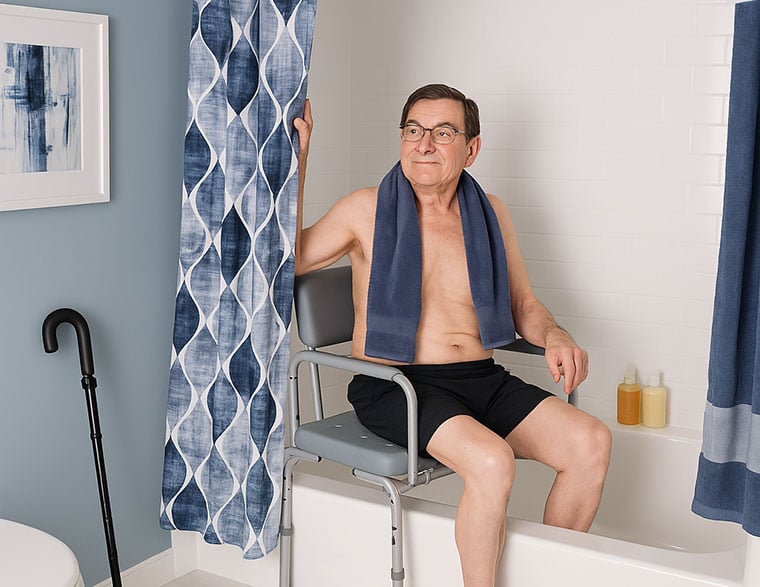Shower Transfer Benches for Elderly

Urinary incontinence (UI) affects up to 30% of older men, often as a result of conditions like overactive bladder, prostate enlargement, or neurological disorders. This not only disrupts daily routines but significantly complicates personal hygiene. Bathing becomes a particularly high-risk task for elderly males with UI due to mobility challenges, urgency to urinate, and slippery surfaces, all of which increase the likelihood of falls and injuries—the leading cause of ER visits among seniors.
Introduction: The Overlap Between Aging, UI, and Bathing Difficulties
Despite the proven benefits of home modifications like grab bars and shower chairs—which reduce falls by up to 19% and dependency by 30%—42% of older adults in the U.S. with bathing or toileting difficulties lack access to needed equipment. Shower transfer benches emerge as a critical assistive tool, improving safety, independence, and dignity during hygiene routines.
This article explores the different types of shower transfer benches, identifies the most suitable option for older men with UI, and offers practical advice to create a safer bathing environment.
Understanding Urinary Incontinence in Older Men
Urinary incontinence (UI) is the involuntary loss of urine and affects a significant number of older men. The most common types include urge incontinence (a sudden, intense urge to urinate followed by leakage), overflow incontinence (due to incomplete bladder emptying), and functional incontinence, where mobility or cognitive impairments delay access to a toilet.
UI increases the risk of falls, particularly during urgent transfers to the bathroom or when walking on wet surfaces after leakage. Studies show that over half of falls in the bathroom among community-living older adults are linked to transfers, such as getting on/off the toilet or into the shower.
Psychologically, UI can lead to embarrassment and anxiety, contributing to avoidance of bathing due to fear of accidents or hygiene concerns. Bathing disability affects nearly 60% of older adults over a 6-year period, with toileting ranked as the third most difficult daily activity. These challenges often result in dependence, reduced self-esteem, and an increased risk of institutionalization and mortality.
Maintaining independence in toileting and bathing is essential for dignity. Addressing UI and improving safety through assistive devices—like grab bars or shower seats—can help preserve autonomy and reduce health risks.
Why Shower Transfer Benches Matter
A shower transfer bench is a long, stable seat designed to bridge the bathtub wall, allowing users to sit outside the tub and slide safely into it. Unlike standard shower chairs that sit entirely within the tub, transfer benches reduce fall risk during entry and exit—critical for patients with urinary incontinence (UI) who may experience urgency during bathing.
These benches support independent hygiene routines, enabling users to remain seated while washing, easing pressure on joints, and avoiding slippery surfaces. According to studies, maintaining independence—both physical and decision-based—is deeply connected to quality of life in elderly populations. Tools like padded, stable benches improve comfort, confidence, and reduce caregiver strain
For individuals with cognitive impairments or dementia, familiar and safe aids reduce agitation, making hygiene routines less stressful. Ultimately, transfer benches foster dignity, autonomy, and well-being in daily care.
Types of Shower Transfer Benches: Features and Use Cases
Shower transfer benches play a vital role in ensuring safe and comfortable bathing for individuals with reduced mobility or urinary incontinence (UI). Depending on the patient's condition and bathroom setup, various types offer different levels of support, space efficiency, and transfer ease. Below are four common types, each with specific features and best-use scenarios:
Standard (Non-sliding) Transfer Bench
A standard transfer bench features a fixed seat that spans the side of the tub. The user sits outside the tub, swings their legs over, and scoots across. It’s ideal for individuals with moderate mobility who can manage some weight shifting and leg movement. While it provides a stable base and support for entry, it may not be suitable for patients with UI urgency due to slower and more effortful transfers. These benches are often more affordable but require significant upper body strength.
Sliding Transfer Bench
The sliding transfer bench includes a seat that moves smoothly along rails. This minimizes physical effort during transfers, making it especially suitable for individuals with urinary incontinence. Because it reduces the time and exertion needed to get into the tub, it helps manage urgency and lowers fall risk. According to the Lund study (2019), patients with UI reported higher satisfaction and safety perception when using sliding benches. They’re an excellent choice for those who need frequent, fast, and supported access to hygiene routines.
Swivel Seat Transfer Bench
This type includes a rotating seat that enhances maneuverability and allows for easier leg positioning. It’s particularly helpful for users with joint pain, hip/knee issues, or balance problems, as it reduces the need for twisting or awkward movements. Google Books highlights that swivel benches are popular in post-surgical recovery, offering a smoother motion for limited-range patients. These are slightly more expensive but beneficial for those needing extra comfort and stability during transfers.
Foldable or Wall-Mounted Benches
Designed for compact spaces, these benches fold away or are mounted to the wall, saving valuable bathroom space. They are best suited for homes with limited room or shared bathrooms. However, they may not be ideal for heavier users or those with poor stability, as some models offer less structural support. As per the Lund study, caregivers noted that while foldable models helped with space efficiency, they were less comfortable and less durable under long-term daily use.

Selecting the Best Bench for Elderly Men with UI
When choosing a transfer bench for elderly men with urinary incontinence, key criteria must be considered: weight capacity, ease of sliding, waterproof or padded surface, and hygiene cut-outs. These features enhance safety, comfort, and dignity during personal care. A sliding transfer bench with a backrest stands out as the ideal option, especially for users dealing with urgency or limited mobility. Its smooth-glide mechanism shortens transfer time—critical for individuals who cannot delay voiding—and helps prevent falls or accidents during hygiene routines.
Adding a padded, antimicrobial surface offers additional comfort and skin protection—important for men managing incontinence-related moisture or skin irritation. Waterproof cushioning that resists bacterial buildup is especially useful in cases of frequent leaks or skin breakdown.
Insights from the one study emphasize the importance of adjustable features in transfer benches, especially removable backrests and armrests, which allow the bench to adapt to individual needs and home environments. Users wanted something stable, adjustable, and non-intimidating in design, rather than a bulky medical device.
Real-world testing showed that caregivers and occupational therapists valued folding armrests, comfort, and easy reach as critical factors.
A broader study found that less than 50% of elderly participants—even those with a known bathing disability—had environmental adaptations like benches or handrails in their homes.
Creating a Safe Bathing Environment: Practical Tips
Creating a safe and functional bathing space is essential for elderly men with urinary incontinence (UI), especially to prevent falls and manage hygiene. Based on observational data, key modifications include installing grab bars, non-slip mats, and a shower or tub seat to ensure stability and ease of movement.
When UI is severe, using waterproof pads or briefs during showering may be beneficial to reduce skin exposure to urine and improve cleanliness during transfers. Caregiver assistance plays a critical role—those trained to help with safe transfers can reduce risk and discomfort for the individual. According to Minkel (2006), many older adults face difficulty installing or using assistive devices due to unclear instructions or physical limitations, underscoring the value of trained support.
Lastly, maintaining a warm, well-lit bathroom can prevent urgency episodes triggered by cold or dim environments. Hygiene of all equipment is essential, as residual urine on benches may lead to skin irritation or breakdown if not regularly cleaned.
Conclusion
As men age, the challenges of urinary incontinence (UI) often extend into daily hygiene—turning simple routines like bathing into risky tasks. Slippery surfaces, urgency episodes, and reduced mobility create a dangerous environment that can lead to falls, injuries, and loss of independence.
Choosing the right shower transfer bench is more than a convenience—it’s a vital tool in preserving safety, comfort, and dignity. A well-fitted, sturdy bench minimizes the risk of injury, supports independence, and reduces stress for both patients and caregivers.
To support hygiene even further—especially during nighttime or between bathing—QuickChange Wraps offer an easy-to-use, skin-friendly solution for managing urine leaks. For those seeking support, we invite you to purchase a 10 Count Trial Pack here or request a professional-use sample pack for healthcare institutions here.
References:
-
Barrick, A. L., Rader, J., Hoeffer, B., Sloane, P. D., & Biddle, S. (Eds.). (2015). Bathing without a battle: Person-directed care of individuals with dementia (2nd ed.). Springer Publishing Company.
-
Doe, J. (2020). Exploring sustainable energy solutions (Master's thesis). Lund University. https://lup.lub.lu.se/student-papers/search/publication/8985359
-
Florence, C. S., Bergen, G., Atherly, A., Burns, E., Stevens, J., & Drake, C. (2018). Medical costs of fatal and nonfatal falls in older adults. J Am Geriatr Soc, 66(4), 693-698. https://doi.org/10.1111/jgs.15304
-
Gill, T. M., Han, L., & Allore, H. G. (2007). Bath aids and the subsequent development of bathing disability in community-living older persons. J Am Geriatr Soc, 55(11), 1757-1763. https://doi.org/10.1111/j.1532-5415.2007.01421.x
-
Lam, K., Shi, Y., Boscardin, J., & Covinsky, K. E. (2021). Unmet need for equipment to help with bathing and toileting among older US adults. JAMA Intern Med, 181(5), 662-670. https://doi.org/10.1001/jamainternmed.2021.0204
-
Malassigné, P., Nelson, A. L., Cors, M. W., & Amerson, T. L. (2000). Design of the advanced commode-shower chair for spinal cord-injured individuals. J Rehabil Res Dev, 37(3), 373-382. https://doi.org/10.1682/JRRD.2000.05.00373
-
National Institute on Aging. (n.d.). Urinary incontinence in older adults. U.S. Department of Health and Human Services, National Institutes of Health. Retrieved April 16, 2025, from https://www.nia.nih.gov/health/bladder-health-and-incontinence/urinary-incontinence-older-adults
-
Naik, A. D., & Gill, T. M. (2005). Underutilization of environmental adaptations for bathing in community-living older persons. J Am Geriatr Soc, 53(9), 1497-1503. https://doi.org/10.1111/j.1532-5415.2005.53458.x
-
Rand, M., Pelchat, J., Levine, I. C., Montgomery, R. E., Greene, R. M., King, E. C., Pong, S. M., & Novak, A. C. (2024). Efficacy of installation of temporary bathing transfer aids by older adults. Gerontol Geriatr Med, 10, 23337214241237119. https://doi.org/10.1177/23337214241237119

